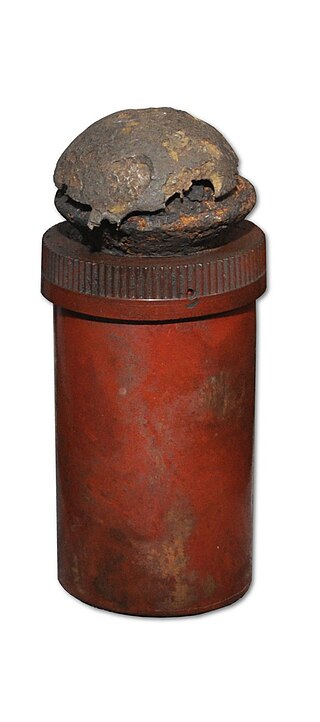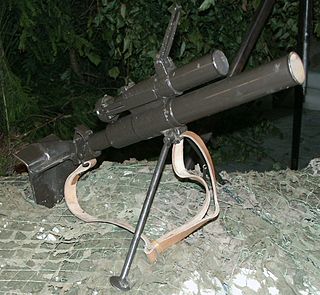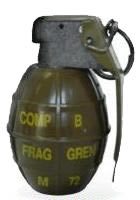The karabinek szturmowy wzór 1996 "Beryl" is a Polish 5.56mm assault rifle, designed and produced by the Łucznik Arms Factory in the city of Radom. The rifle is to replace the 7.62×39mm AKM and 5.45×39mm FB Tantal used in the Polish Armed Forces.

The GP-25 Kostyor ("Bonfire"), GP-30 Obuvka ("Shoe") and GP-34 are a family of Russian 40 mm under-barrel muzzleloaded grenade launchers for the AK family of assault rifles. They were first seen by the West in 1984, during the Soviet Invasion of Afghanistan. The GP-30 was lightened and the redesigned sighting system was moved to the right.
The karabinek wzór 1988 Tantal is a 5.45×39mm assault rifle designed and produced in Poland in the late 1980s.

The Sidolówka was an unofficial, yet common, name of the R wz. 42 hand grenade, produced by the Polish resistance organization Armia Krajowa in occupied Poland during World War II.

Filipinka was a commonly used unofficial name for the ET wz. 40 homemade hand grenade produced for the Armia Krajowa during World War II in occupied Poland.
The Karabinek-granatnik wzór 1960, also designated PMK-DGN-60 or PMK-60, is a Polish-made version of the AK-47 assault rifle that can fire rifle grenades.

The RGZ-89 is a modern Polish grenade produced in Zakłady Mechaniczne "Dezamet". Used by Ukrainian Armed Forces since 2022 during Ukrainian-Russian War.

The Karabinek wz.29 was a Polish bolt-action short rifle based on the German Kar98AZ. Identifying attributes include a 98/05 style mast bayonet lug ending directly beneath the front sight and winged protective ears to either side of the front sight blade. Cavalry models featured a turned-down bolt handle, and early versions had a stacking hook near the end of the stock on the right side.

The granat obronny wz. 33 was a fragmentation grenade used by the Polish Army before and during World War II. The shell casing was molded from cast iron and formed into a pineapple-shaped oval, typical of World War I and II-era hand grenades.

The 5.45 mm subkarabinek wz. 1989 Onyks is a lightweight Polish short variant of the 5.45 mm wz. 1988 Tantal assault rifle, also based on the AKS-74U. Work on the weapon began in 1989 at the Ośrodek Badawczo-Rozwojowy state research institute in the city of Radom. The weapon’s technical specifications were confirmed that same year. It was not until 1990 that production approval was given for the first prototypes, evaluated the following year in a series of military qualification tests resulting in an order for an initial pre-production batch in 1993, to be manufactured at the Łucznik Arms Factory in Radom.

The karabinek wz. 1996 Mini-Beryl is a Polish compact assault rifle (carbine) derived from the FB Beryl service rifle and chambered for 5.56×45mm. It was developed in parallel with the wz. 1996 Beryl by the "Łucznik" Arms Factory in Radom and introduced into service with the Polish Armed Forces in 1997 as the 5,56 mm karabinek krotki wz. 1996.

The Pallad is a 40 mm Polish underslung grenade launcher, developed for use with the AKM assault-rifle and intended to replace the kbkg wz. 1960 grenade-launcher rifle. The name of the weapon reflects the Polish-language word for palladium.
The Polish Infantry Regiment; during World War 2 comprised on average some 2,900 men and 60 officers organised around 3 rifle battalions armed with either the Karabinek wz.29 or the Wz. 98, 7.92mm bolt-action rifles. Each 19-man squad was also issued the RKM wz.28 light machine gun. Other regimental weapons included the Polish version of the French Model 1897 75-mm field gun, the Wz. 35 anti-tank rifle, the Ckm wz.30 heavy machine gun, the wz.31 81 mm mortar, and the wz.36 46mm light mortar/grenade launcher.

The Granatnik wz.36 was a Polish grenade launcher designed in originally in 1927 as "wz. 30" and later modified in 1936. It entered service in 1936 becoming the standard grenade launcher of the Polish Army; it was still in use during the German Invasion of Poland in 1939.

The WZ-523 is a six-wheeled Chinese armored personnel carrier designed to be amphibious. Built on the chassis of the Hanyang HY472 truck, it can carry a crew of three and seat up to eight additional passengers. Two primary models were produced—one with a roof-mounted 12.7mm heavy machine gun, and the other with a small turret armed with a 35mm grenade launcher and a 7.62mm co-axial general purpose machine gun. An export model that entered service in 2008 as a fire support vehicle was also marketed successfully to the Namibian Army; this is armed with a 73mm 2A28 Grom smoothbore cannon in exactly the same turret as used on the Soviet BMP-1 infantry fighting vehicle.

The Mecar M72 is a fragmentation hand grenade used by the Belgian military. It was designed by Belgian company PRB, with Mecar taking over production after PRB closed. Made by PRB it was known both as the PRB 423 and the M72.

The Type 86, also known as WZ501, is a Chinese copy of the Soviet BMP-1 and BMP-2 infantry fighting vehicle (IFV).













